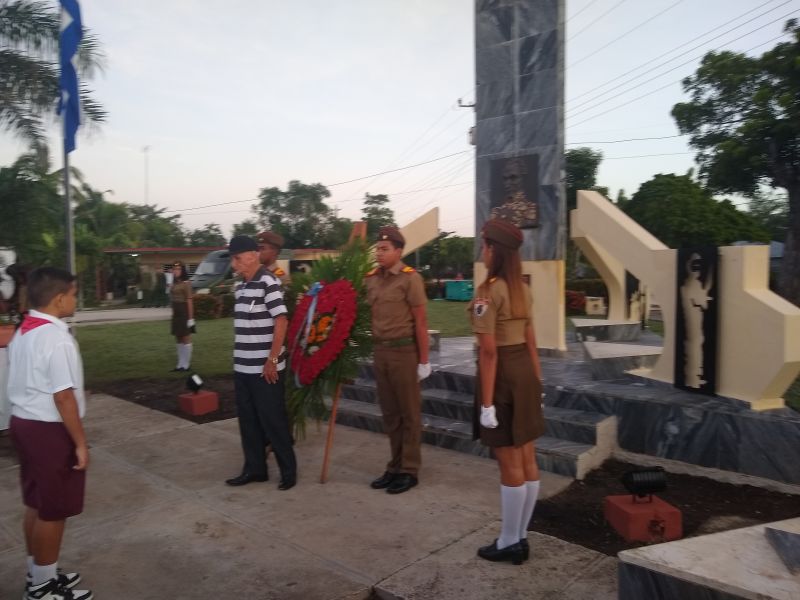 The mission of the guerrillas of the IV Front consisted of operating on the Central Highway in the section between Holguín and Buenaventura with the objective of opening fire on military transports that were circulating, as well as intercepting civilian vehicles that were transporting agricultural products or provisions of all kinds. . Any army vehicle that tried to travel was shot at and that is why they began to pass in long convoys. By then the soldiers did not venture to travel at night.
The mission of the guerrillas of the IV Front consisted of operating on the Central Highway in the section between Holguín and Buenaventura with the objective of opening fire on military transports that were circulating, as well as intercepting civilian vehicles that were transporting agricultural products or provisions of all kinds. . Any army vehicle that tried to travel was shot at and that is why they began to pass in long convoys. By then the soldiers did not venture to travel at night.
For this mission, positions were assigned to the different squads. Manuel Ramírez acted at the Cruce de Mir and between Las Casimbas and the Cruce de Guayabo Ariel Zamora's squad was located; in Las Calabazas, that of Lorenzo Torres Pons and in Cruce de Dovales, that of Abreu Roch[1].
These squads had different positions but as events unfolded they gathered to carry out a certain action and then returned to their positions. As a strategy, given the proximity of the Regiment and the unfavorable terrain, a space between the Maceo Crossing and the city of Holguín was left uncovered, as well as between Buenaventura and Las Parras where the forces of Column 12 led by Lalo Sardiñas acted. .
Another mission was to prevent the army from reaching a place called Cupey, where there was a camp where Orlando Lara was.
Cristino's forces also operated in the territory under the command of Corcinio Fajardo in the area of Jagüeyes, Sabanazo, Padierne, Cañada Honda, Omaja and San Agustín, organizing riflemen, collaborators, locating places where the troops would operate and possible camping sites. The group operated from the mountains of Canada in the Sabanazo area in the south, to the Puerto Padre area in the north, Las Parras and La Chambelona in the west and Domínguez, Santa Inés in the east.
The Central Highway was interrupted between the Maceo Crossing and the Las Calabazas Crossing and was destroyed between Las Calabazas and the Guayabo Crossing and between the Dovales Crossing and the Maceo Crossing, and the Las Calabazas bridge was also demolished.
On November 18, at night, the Buenaventura power plant was burned with a view to preparing conditions for the planned attack on the Rural Guard barracks in this town. The action was led by Jesús Serrano Santiesteban and Roberto participated. Fernández Rodríguez, Abilio Rivera Ricardo, Remigio Santiesteban Reyes and Pedro Córdova Pérez.[2]
During the first days of December, clashes continued against enemy units that were trying to circulate on the roads, encountering rebel control of the territory and an example of this was the capture on the 12th, in the place known as Los Almácigos, of a small plane belonging to the Holguín Regiment that made a forced landing on the road due to inclement weather.
Every convoy that came from Tunas or Holguín tried to cross the territory was heavily harassed on its way, especially in Las Calabazas or Cruce de Mir, the enemy columns became increasingly scarce and their pace slower as they had to designate a strong number of men and equipment for its transfer.
At the Las Calabazas curve, on December 13, 1958, a convoy from Camagüey guarded with tanks and 30 and 50 caliber machine guns located on trucks was shot at and an enemy patrol that left Holguín heading to Las Tunas was ambushed. The enemy, traveling in 11 armored trucks and a tank, had to return despite their technical superiority. The rebel troops dominated from Yareyal to Buenaventura.
Batista's army had an important military communications relay post located at the top of the Las Mantecas hill guarded by twelve soldiers from the Military Emergency Service. It was a repeater trunk station that allowed communications from Oriente to Camagüey.
The collaborators in the area instructed the rebels about the most accessible places to climb to the place through a small mountain, but the action had to be aborted because the small troop lost their way. Finally, at dawn on December 15, the action took place.
The assault was carried out by four squads that entered the enemy position from different places.
Ten prisoners were captured and some war material was seized. Corporal Luís Colón and soldier Aldo Álamo, who facilitated the delivery, joined the Rebel Army.
On the 17th of the same month, another rebel group led by Carlos Díaz Acosta returned to the place to destroy the transmitter.
[1]Collective of Authors. Special Operations Mission. E. Holguín. p. 67
[2]EdilbertoAlmenares.Local Chronology.













